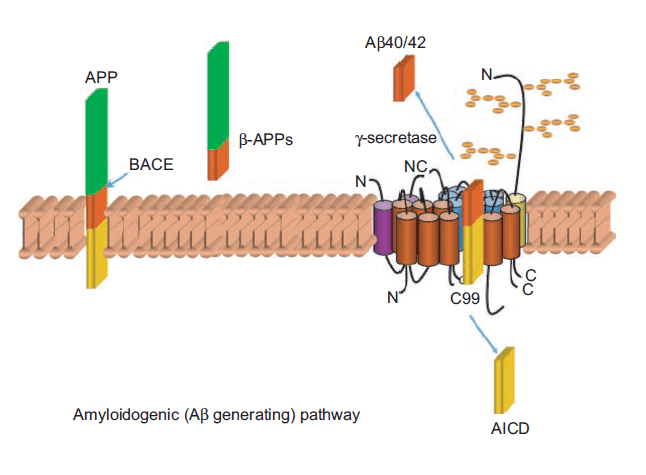MemPro™ Gamma secretase
Creative Biostructure provides custom MemPro™ gene-to-structure services for gamma secretase.
Gamma secretase is a multi-subunit protease complex that cleaves single-pass transmembrane proteins at residues within the transmembrane domain. It plays an essential role in Alzheimer’s disease (AD) process. AD is a complex, progressive neurodegenerative disorder that is characterized by extensive neuronal loss and the presence of neurofibrillary tangles and senile plaques. AD patient suffers from an accumulation and deposition of a small peptide referred to as beta amyloid (Aβ) within brain tissue. The abnormal accumulation results in neuronal loss or dysfunction through a cascade of events that include the generation of free radicals, mitochondrial oxidative damage and inflammatory processes. Amyloid precursor protein (APP) is thought to be the parent molecule of Aβ could be cleaved by three major secretases, while gamma-secretase catalyzes the final step in the pathway to liberate the Aβ peptides.
Gamma-secretase enzyme is an aspartyl protease that has unique ability to regulate intramembrane proteolysis for a variety of type 1 integral membrane proteins which include, APP. Gamma secretase have identified four components: presenilins, nicastrin, anterior pharynx defective (aph-1) and presenilin enhancer 2 (pen-2).
- Presenilins are nine-pass transmembrane proteins and considered to possess enzyme catalytic activity.
- Nicastrin is a single pass membrane protein with a large ectodomain that is heavily glycosylated which plays help gamma-secretase assembling.
- Aph-1 occurs as a seven-pass transmembrane protein that could be further divided into two homologous forms, which located on chromosome 1 and chromosome 15 (aph-1a & aph-1b) respectively; Aph-1a undergoes further splicing to generate a long and short isoform of aph-1a, with the short isoform more abundantly expressed in most tissues. Aph-1 shares its function with nicastrin in forming the stable complex.
- The smallest component Pen-2 is a two-pass transmembrane protein that is thought to activate presenilin endoproteolysis. These proteins are essential for gamma-secretase activity.
 Figure 1. Proteolytic processing of APP
Figure 1. Proteolytic processing of APP
Thus, overall the enzyme possesses 18 transmembrane domains making it difficult to elucidate the crystal structure of the enzyme. The proteins are adapted to the lipid bi-layer and are easily to denature and lost biological functions when extracted from the environment. The region of hydrophobic residues will require specific procedure to be stabilized by detergents during preparation for structural analysis. High resolution X- ray crystallography methods have improved in which 3D crystallization methods can be used.
Several drugs act as gamma-secretase inhibitors have been developed to treat Alzheimer’s diseases. However, since gamma-secretase has more than 50 different substrate, concerns have been about the specificity, selectivity and toxicity of agents aimed at inhibiting or modulating gamma-secretase activity. Meanwhile, the reason about the process of Alzheimer’s diseases still remains unclear and gamma-secretase inhibitors can only treat symptoms without targeting the underlying pathology or neurodegeneration.
References:
Krishnaswamy S, Verdile G, Groth D, et al. The structure and function of Alzheimer’s gamma secretase enzyme complex[J]. Critical reviews in clinical laboratory sciences, 2009, 46(5-6): 282-301.
